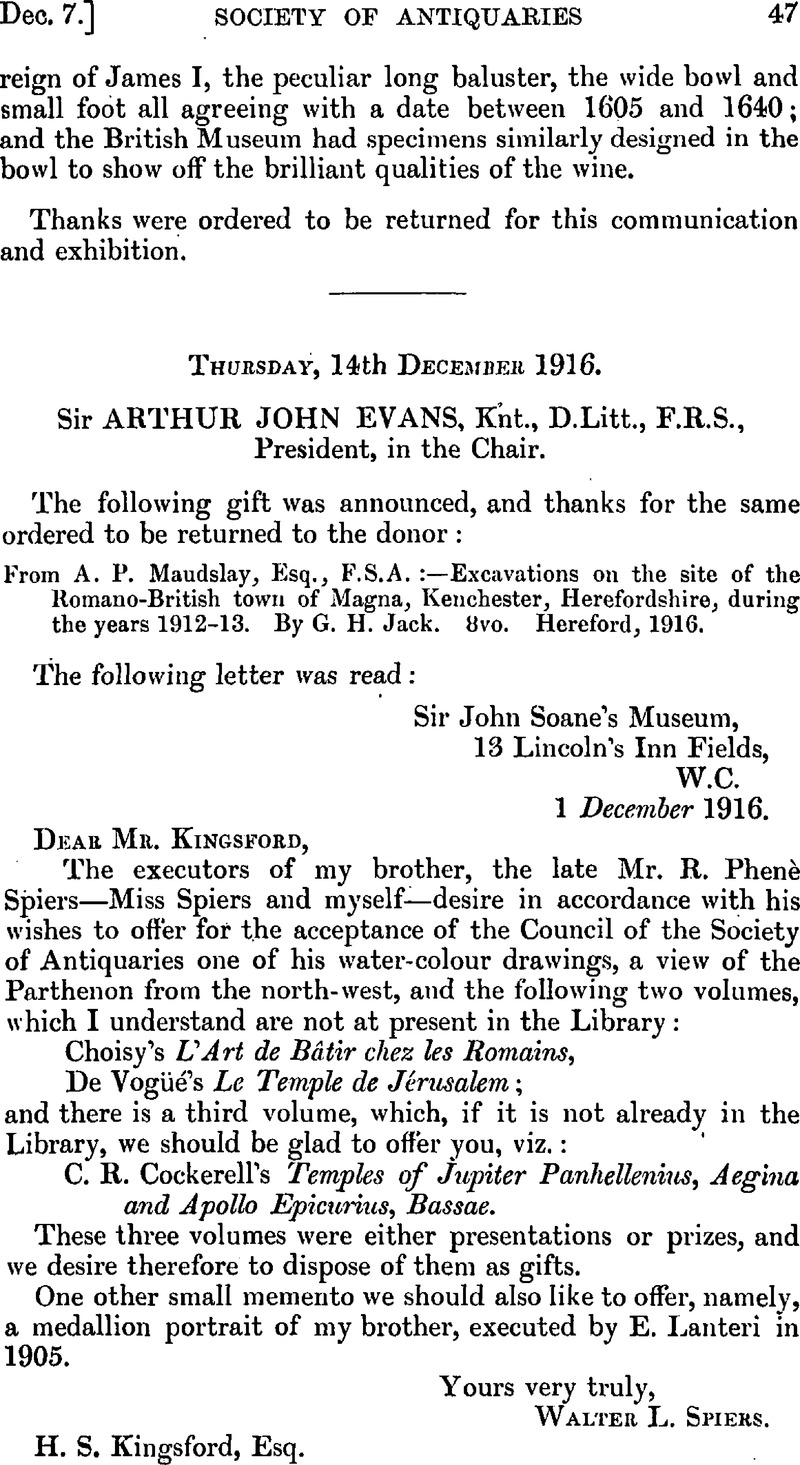No CrossRef data available.
Article contents
Thursday, 14th December 1916
Published online by Cambridge University Press: 10 May 2010
Abstract

- Type
- Proceedings
- Information
- Copyright
- Copyright © The Society of Antiquaries of London 1917
References
page 48 note 1 Proc. Birmingham Philosoph. Soc. iv, pt. i, 179.
page 49 note 1 J. Y. Akerman, Pagan Saxondom, pl. vi.
page 52 note 1 One example is figured in Baron de Baye, Industrial Arts of the Anglo-Saxons, pt. viii, 1; Archaeologia, lxiii, pi. xxviii, 8; and Baldwin Brown, The Arts in Early England, iii, pi. lxix, 1.
page 55 note 1 Its weight is 39 grains. On the question of weights from Anglo-Saxon graves, see Baldwin Brown, op. cit. iv. 417 H.
page 56 note 1 Nenia Britannica, p. 33, pi. xii, fig. 9.
page 56 note 2 Inventorium Sepulchrale, p. 23, pi. xvii, figs. 2 and 3.
page 56 note 3 Archaeologia, xxxviii, p. 344, and fig.
page 57 note 1 Mr. Kenward in his account states that fifty-eight graves were opened up to 24th May 1883, twenty-four of them before 29th January 1883, when the Ashmolean authorities began the work. This seems to be due to a misapprehension. Not until 11th April was the work actually taken over by the Ashmolean authorities. The notes of the first fifteen graves opened after 29th January are in Mr. Gale's handwriting, and the figure twenty-four mentioned by Mr. Kenward is made up of these fifteen and the estimated number found before news of the discoveries was brought to the Ashmolean Museum. There is evidently a confusion between the work done for and done by the museum.
page 59 note 1 Archaeologia, lxiii. 193.
page 59 note 2 Roach Smith, Faussett's Inventorium Sepulchrale (frontispiece).
page 59 note 3 Baldwin Brown, The Arts in Early England, iv, pi. cxlv.
page 59 note 4 Akerman, Pagan Saxondom, pi. xxxviii.
page 59 note 5 Archaeologia, xxxviii, 334.
page 59 note 6 Ibid, xxxviii, 17 (grave 71); pi. xix, fig. 2.
page 59 note 7 Ibid, lxiii, pi. xxviii, fig. 7.
page 59 note 8 Baldwin Brown, op. cit. iii, pi. lxxxi, 4 and 6.
page 60 note 1 The Brixwortli pin cannot be reckoned as representative of early Anglo-Saxon work ; Mr. T. J. George has informed the writer that it was found with a coin of Cuthred (A.B. 789–805) and therefore belongs rather to the late Saxon period, with the art of which its decoration shows closer affinity.
page 60 note 2 Archaeologia, liv, pi. ix, 5.
page 60 note 3 Journ. Royal Anthrop. Instit. xlv. 107.
page 61 note 1 The Arts in Early England, iii. 158 f.
page 62 note 1 Op. cit. iii. 154.
page 62 note 2 Cp. a similar doubtful case at Ellesborough (Records of Bucks, ix. 425).
page 63 note 1 Baldwin Brown, op. cit. iv. 658.
page 63 note 2 Ibid, iv, pi. civ, 1.
page 64 note 1 e. g. J. H. Müller, Vor- und frühgeschichtliche Alterthümer der Provinz Hannover, pl. xxi, no. 199, and pl. xxii, no. 212.
page 64 note 2 The Archaeology of the Anglo-Saxon Settlements (Oxford, 1913).Google Scholar




